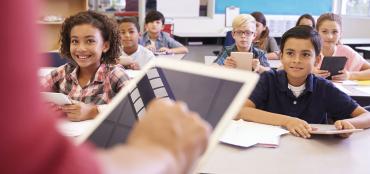Ensuring our children become knowledgeable and engaged citizens is critical for their success and our country’s future. With “fake news” being broadcast as fact, and with access to vast amounts of information on social media, students face an ever-growing challenge to discern what is true.
Educators must actively cultivate students’ curiosity about what’s in the news and teach them the critical-thinking skills required to zero in on what is accurate and responsible journalism. To that end, Share My Lesson has partnered with reputable news organizations to bring broadcast and audio stories into the classroom and to provide webinars and lesson plans on how to be a discerning news consumer.
Get Them Hooked
A news story designed for classroom use should capture students’ attention, inspire discussion, and ultimately get them hooked on the news. For educators looking to seamlessly fit a discussion of current events into their classrooms, Share My Lesson’s “Today’s News, Tomorrow’s Lesson” collection delivers three- to five-minute news stories, with accompanying text, questions, and short activities, on a daily basis from PBS NewsHour Extra, Listenwise, and Science Friday.
Fact vs. “Fake News”
Media literacy is not something students are born with; assessing various types of media must be learned. Students need instruction and opportunities to practice deciphering fact from fake news. In general, evaluating the veracity of a story requires asking some foundational questions: Who is the source of the information? Does the story have strong evidence? Are other reliable sources sharing similar information? A student may also need to learn how to pose more detail-oriented questions: Is this the most up-to-date and informed report? Does this source offer contact information? What kinds of ads appear on the web page or take place during commercials?
The Newseum, the Stanford History Education Group (whose work is featured on page 4 of this issue), and PBS NewsHour Extra all have prerecorded webinars for teachers on media literacy. PBS NewsHour Extra also offers a lesson plan for students in grades 7 to 12 called “How to Teach Your Students about Fake News.” On Share My Lesson, teacher Barbara Tutino’s lesson “The Trouble with Reality—Fake News” uses text, video, and Twitter examples to help students separate rhetoric from reality.
Keeping It Civil: Classroom Discussions
Staying up to date on current events empowers students to intelligently discuss what’s going on in the world. Within a classroom, watching students share their knowledge can be both exhilarating and nerve-racking—what if things get too heated?
Allowing students to reflect on current events supports their development as responsible citizens. But setting boundaries for discussion is just as important. Doing so can encourage students to express themselves, since they know what is expected of them and their peers. Teaching Tolerance’s “Civil Discourse in the Classroom” is an invaluable resource on the subject that includes everything from how the historic role of civil discourse has shaped our country to how to effectively create and defend an argument.
It goes without saying that news events are bound to create emotional situations. And unless we teach students how to express themselves in respectful ways, their voices won’t be heard.
–THE SHARE MY LESSON TEAM

